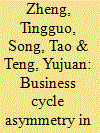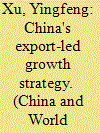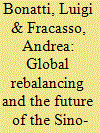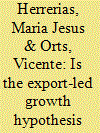|
|
|
Sort Order |
|
|
|
Items / Page
|
|
|
|
|
|
|
| Srl | Item |
| 1 |
ID:
097832


|
|
|
|
|
| Publication |
2010.
|
| Summary/Abstract |
Friedman's plucking model of business fluctuations suggests that output cannot exceed an upper limit, but it is occasionally "plucked" downward below trends as a result of economic recessions. This paper investigates China's business fluctuations using quarterly real GDP data for the period 1978-2009. Our results show some evidence supporting Friedman's plucking model. We find that a ceiling effect of real output exists, and that negative asymmetric shocks significantly affect the transitory component, which captures the plucking downward behavior during the recession. The results also suggest that the basic asymmetric unobserved component model is not appropriate for directly modeling China's real output because the business cycle is inaccurately measured, but it works quite well when considering a structural break in the second quarter of 1992. The results reveal that although China's economy strengthened in the second quarter of 2009, it is essential for China's government to take further positive and effective measures to maintain sustainable development of the economy.
|
|
|
|
|
|
|
|
|
|
|
|
|
|
|
|
| 2 |
ID:
097824


|
|
|
|
|
| Publication |
2010.
|
| Summary/Abstract |
A pressing challenge for China is determining where to accommodate millions of migrant workers displaced by the closing of many export-oriented factories. The current global financial crisis has exposed the fragility of the export-led growth strategy China has adopted over the past 30 years. Is there a better alternative for providing non-agricultural jobs than the sweatshops of cheap export production? In the present paper, international experience is reviewed to shed light on China's situation. Using pooled regression models, we analyze data from the World Bank for 209 economies. We investigate the experience of other economies to answer the following questions: What is the common process of expanding the non-agricultural economy? How is that process affected by the level of the real exchange rate? Is export production a common way of absorbing surplus rural labor? Finally, what are the ways that domestic demand and service employment can be expanded?
|
|
|
|
|
|
|
|
|
|
|
|
|
|
|
|
| 3 |
ID:
097822


|
|
|
|
|
| Publication |
2010.
|
| Summary/Abstract |
This paper attempts to explain the fundamental cause of China's growing imbalance problems. Economic data confirm that the key structural imbalance problems, such as overinvestment, large current account surpluses, low consumption share of GDP and income inequality, have all deteriorated over the past few years, despite continuous policy efforts to correct these problems. We argue that the key determining factor is repressed factor cost, which is associated with heavily distorted markets for labor, capital, land, resources and the environment. These are like implicit subsidies for producers, investors and exporters. They boost growth and, at the same time, lift investment and exports. Previous policy efforts have focused more on administrative measures, which have not been sustainable. Therefore, a more fundamental solution to the imbalance problem lies in completing market-oriented reforms for production factors and allowing free markets to determine prices of labor, capital, land and resources.
|
|
|
|
|
|
|
|
|
|
|
|
|
|
|
|
| 4 |
ID:
097830


|
|
|
|
|
| Publication |
2010.
|
| Summary/Abstract |
The crisis of 2008 has shown the unsustainability of the global imbalances centered on the US-China symbiotic relationship that characterized the previous decade. This has revived the so-called growth-rebalancing debate. In particular, the new emerging consensus calls for a re-orientation of the US economy away from consumption and toward exports, and for policy shifts that can help China to reduce its dependence on external demand and inefficiently high rates of capital accumulation. We discuss the economic and political feasibility of the proposed patterns of re-adjustment by focusing on the short-term and long-term trade-offs faced by the policy-makers. We argue that the rebalancing will be gradual and partial because of the costs associated with a radical shift in the growth models adopted by both countries. We believe that this scenario will be consistent with a world economy expanding at lower rates than over the past decade.
|
|
|
|
|
|
|
|
|
|
|
|
|
|
|
|
| 5 |
ID:
097826


|
|
|
|
|
| Publication |
2010.
|
| Summary/Abstract |
One of the missing pieces preventing us from understanding recent Chinese economic development is the role played by openness and capital accumulation in this process. The question is whether the sharp economic growth that the Chinese economy has experienced is another case of export-led growth due to the open-door policy or whether, on the contrary, this growth has been caused by high domestic savings and investment rates (and the consequent capital accumulation). To answer this question, we employed an empirical framework of the cointegrated vector autoregressive model. The empirical results show that both investment (in physical capital and R&D) and exports, as well as the exchange rate policy, are relevant factors in explaining China's long-run economic growth over the past 4 decades.
|
|
|
|
|
|
|
|
|
|
|
|
|
|
|
|
| 6 |
ID:
097831


|
|
|
|
|
| Publication |
2010.
|
| Summary/Abstract |
Consistency is essential in statistical data processing. This paper reports some notable discrepancies in China's GDP accounting, which are unexpectedly found after testing the consistency of GDP accounting and its components. Although these discrepancies are mainly attributed to the revision methodology adopted after the 2004 economic census, the intention to harmonize GDP accounting data, in terms of production and expenditure, also contributes to the discrepancies. Our finding highlights the need for careful checking of consistency and for testing before formal release of any official statistics.
|
|
|
|
|
|
|
|
|
|
|
|
|
|
|
|
| 7 |
ID:
097829


|
|
|
|
|
| Publication |
2010.
|
| Summary/Abstract |
In responding to a view that attributes sharp downturns in the Chinese economy in late 2008 and early 2009 to the "collapse of external demand," the present paper scrutinizes three relevant issues: How have large Chinese importers behaved in a demand-price setting? How have Chinese commodity imports and exports interacted in recent years? Did the downturns in China's export growth come earlier and were they deeper than those in Chinese import growth? All answers appear to suggest a conclusion contrary to the abovementioned view: sharp downturns in China's trade and economy during the recent global financial crisis were, to a large extent, caused by certain domestic factors, or by factors that should not be regarded as entirely "external." Insomuch as globalization has advanced, a large economy like China's today faces new potential sources of macroeconomic disturbances, from inside and outside.
|
|
|
|
|
|
|
|
|
|
|
|
|
|
|
|
|
|
|
|
|